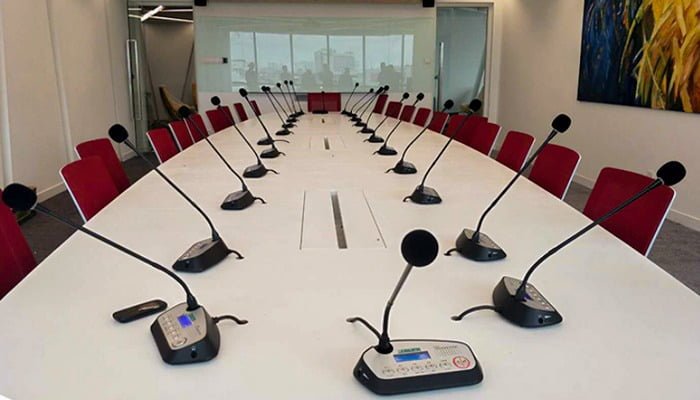Introduction to Audio Conference Systems
In today’s world of digitalization, the importance of effective communication has become the foundation of business and organization success across the globe. With the technology landscape continuing to change, the need for seamless communications solutions has increased, especially because of the rise of remote working and international collaborations. This has led to the vital role of audio conference technology, which allows people and groups to connect and work effectively over vast distances in real-time.
Evolution of Audio Conferencing
The story of audio conferencing began using analog technology, to the advanced digital technologies of the present. Every technological advance, audio conferencing has evolved and changed, aided by advances in communication and audio technology that are changing the way people connect and work.
Key Components of an Audio Conference System
The heart of any audio-conferencing system is an array of vital components that are in sync to allow an efficient and effective audio conference.
Microphones
The microphones are the ears of conference equipment, recording audio from those in the room for transmission of the audio to attendees who are located elsewhere. Based on the conference setting and the requirements, a variety of microphones like Gooseneck microphones, boundary microphones and wireless lapel microphones are used.
Speakers
The speakers play an essential role in recapturing the sound of distant participants, making sure that the voices of participants are heard clearly in the conference space. Speakers of high-end quality are essential to provide clear, natural audio.
Audio Mixer
A mixer that plays audio functions as the facilitator for the system of conference permitting the control of audio volume and seamless integration of various audio sources. The mixer allows users to mix different audio sources seamlessly during a conference call.
Control Interface
Control interfaces are the central point of control for the entire system. It provides users with easy-to-use controls for managing all elements of the meeting which include volume adjustments as well as mute/unmute and mute functions. The ability to set audio preferences.
Types of Audio Conference Systems
Audio conference systems are available in many forms that cater to the diverse demands and needs of participants.
Wired Audio Conferencing Systems
Wired systems are based on physical connections like connectors and cables to transfer audio signals between different devices. Though they require more installation effort, wired systems provide unbeatable reliability and interfering-free audio transmission.
Wireless Audio Conferencing Systems
Wireless devices make use of the latest technology for wireless, like Bluetooth or Wi-Fi, in order to send audio signals, without the restrictions of physical cables. The systems provide unparalleled versatility and flexibility, allowing users to communicate and connect easily from anywhere.
Advantages of Audio Conference Systems
The use of audio conference technology brings a variety of advantages that transform the way we communicate and collaborate.
Flexibility and Mobility
Audio-conferencing crosses boundaries of geography it allows users to attend gatherings from anywhere that has access to the Internet. This means that there is no need to travel, and it allows remote working and virtual collaboration.
Cost-Effectiveness
When compared to traditional face-toface gatherings, audio-conferencing can provide huge savings in costs by cutting down on expenditures for travel as well as overhead costs for hosting physical meetings.
Enhanced Collaboration
Audioconferencing facilitates real-time communications and collaboration between remote teams, which allows them to share thoughts, make decisions and resolve problems faster.
Factors to Consider When Choosing an Audio Conference System
Deciding to choose an appropriate audio conference software requires an in-depth analysis of a variety of factors to guarantee compatibility and maximum performance.
Room Size and Layout
The size and configuration of the conference space determine the design and type of audio system needed to ensure adequate coverage as well as audio quality.
Audio Quality
High-quality audio is essential to ensure a smooth and efficient conference. Make sure you choose equipment that provides crystal-clear and natural-sounding audio with no distortion or background sound.
Compatible with existing Infrastructure
Check that the audio conference system is seamlessly integrated into your existing communications infrastructure. This includes telephone systems, videoconferencing platforms, as well as collaboration tools.
Top Brands in Audio Conference Systems
A number of renowned brands provide top-of-the-line audio conferencing services that are designed to accommodate the different needs of organizations and businesses.
Bose
The company is renowned for its genuine audio technologies; Bose offers a wide variety of audio conferencing solutions that are renowned for their superior audio quality and performance.
Shure
An established name in the field of audio, Shure specializes in professional-grade microphones and audio equipment that is designed specifically for broadcasting, conferencing, and conference applications.
Poly
Before that, it was named Polycom previously known as Polycom Plantronics; Poly is a prominent supplier of solutions for video and audio conferencing that include headsets, conference phones and headsets. Poly is known for their dependability as well as performance.
Tips for Setting Up an Effective Audio Conference System
The setup of an audio conference system demands meticulous planning and care to the smallest of details to ensure maximum performance and customer satisfaction.
Proper Placement of Microphones and Speakers
Set up microphones strategically so that they can capture the audio of every participant while positioning speakers where they will provide uniform coverage while minimizing reflection and echo.
Testing and Calibration
Before you conduct the conference call, you must thoroughly check the audio conference system to make sure that all elements are working properly, and then calibrate the audio levels to ensure maximum audio clarity as well as volume.
Providing User Training
Give users a comprehensive education about how to utilize the audio conference system efficiently by adjusting the mic settings, muxing and unmuting and common troubleshooting issues.
Common Challenges and Solutions in Audio Conferencing
While they offer many benefits Audio conferencing systems can have issues that could affect the quality of calls and experience for users.
Echo and Feedback
Feedback and echo can alter the quality of audio due to the speaker’s sound getting heard by microphones. Limit these problems by altering the speaker and microphone placement and using acoustic techniques.
Connectivity Issues
Insufficient connectivity to the internet or network may result in dropping calls and lagging audio. Make sure you have a reliable internet connection, and think about switching to a dedicated system that supports audio conferencing to limit interruptions.
Background Noise
Background noises from a variety of sources may affect the clarity of audio during conferences. Utilize noise-canceling microphones or Acoustic treatment to minimize background noise and improve the quality of calls.
Future Trends in Audio Conferencing
With technology continuing to develop as it does, the future of audioconferencing is promising for a more seamless and immersive communications experience.
Integration with Video Conferencing
Audio conferencing systems will more often be integrated with video conferencing platforms and provide participants with a seamless interaction experience that includes audio, video, as well as capacity for sharing content.
AI-driven Audio Enhancement
The advancements made in the field of artificial intelligence (AI) technology can allow audio-conferencing systems to intelligently alter audio settings in response to specific conditions in the environment as well as preferences from users to ensure optimal audio quality, whatever the setting.
Virtual Reality Integration
Virtual virtual reality (VR) technology is set to change audio conferencing, by enabling environments that are immersive and virtual that allow participants to engage and collaborate with greater authenticity and enjoyable manner.
Conclusion
In the end, the audio conference system is the most effective way to enhance communications and collaboration in the digital age. When investing in top-quality audio conference solutions, as well as adhering to the best methods for setting up and operating, companies can ensure smooth and efficient remote communication that boosts productivity and innovation.



0 Comments on “Unveiling the Power of Audio Conference Systems: Enhancing Communication in the Digital Era”